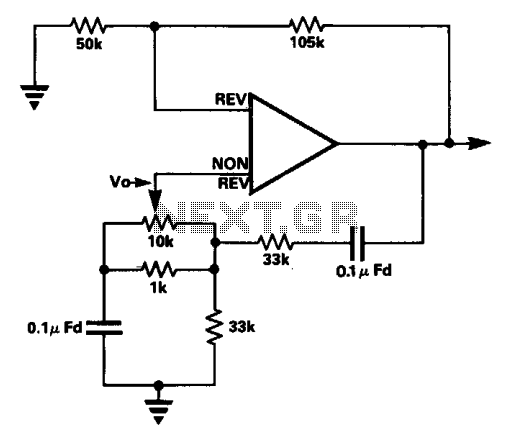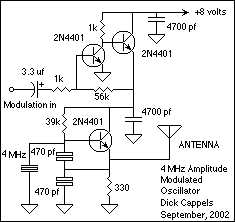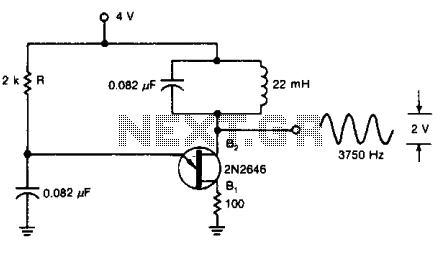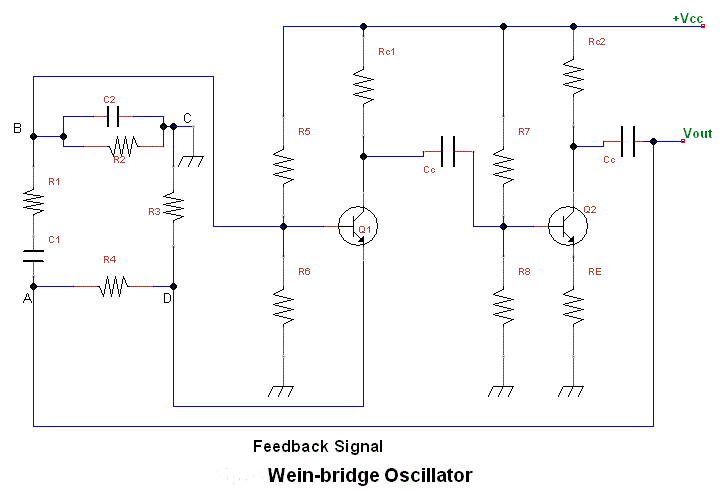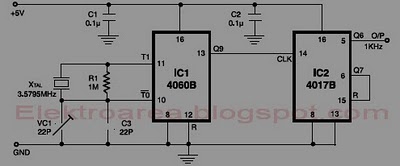
CD4047 CMOS OSCILLATOR
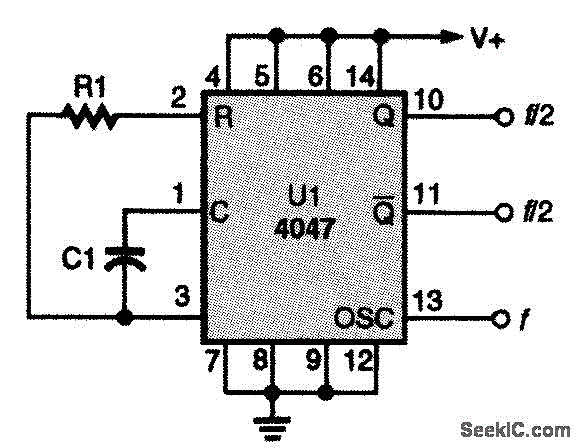
This CMOS square-wave oscillator utilizes the 4047 multivibrator circuit, suitable for both monostable (one-shot) and astable applications. In the provided configuration, the 4047 operates as an astable multivibrator. The circuit features three outputs from the 4047, with the first being the oscillator (OSC) output, which connects directly to the internal oscillator circuitry.
The 4047 CMOS multivibrator is a versatile component that can generate square wave signals at various frequencies, making it ideal for clock generation, tone generation, and pulse-width modulation applications. In the astable mode, the 4047 continuously switches between its high and low states, producing a square wave output.
The frequency of oscillation can be adjusted by varying the external resistors and capacitors connected to the 4047. Typically, two resistors (R1 and R2) and a capacitor (C1) are used in conjunction with the device. The relationship between these components determines the frequency (f) and duty cycle (D) of the output waveform. The frequency can be calculated using the formula:
f = 1 / (0.693 * (R1 + 2*R2) * C1)
The duty cycle, which defines the proportion of time the output is high versus low, can be adjusted by changing R1 and R2. This flexibility allows the designer to tailor the oscillator's characteristics to meet specific application requirements.
The three outputs provided by the 4047 include the OSC output, which delivers the square wave signal, and two additional outputs that can be used for various purposes, such as driving LEDs or interfacing with other digital circuits. The outputs are typically TTL-compatible, allowing for easy integration into existing digital systems.
In summary, the 4047 multivibrator circuit configured as an astable oscillator is a robust solution for generating square wave signals in a variety of electronic applications. Its adjustable frequency and duty cycle, combined with multiple outputs, make it a valuable component for engineers and designers in the field of electronics.This CMOS square-wave oscillator is based on the 4047 multivibrator circuit, which can be used for either monostable ( one-shot ) or astable applications. In the configuration shown, the 4047 is an astable multivibrator. There are three outputs from the 4047. The first is the oscillator (OSC) output, which is connected directly to the internal oscillator c.. 🔗 External reference
The 4047 CMOS multivibrator is a versatile component that can generate square wave signals at various frequencies, making it ideal for clock generation, tone generation, and pulse-width modulation applications. In the astable mode, the 4047 continuously switches between its high and low states, producing a square wave output.
The frequency of oscillation can be adjusted by varying the external resistors and capacitors connected to the 4047. Typically, two resistors (R1 and R2) and a capacitor (C1) are used in conjunction with the device. The relationship between these components determines the frequency (f) and duty cycle (D) of the output waveform. The frequency can be calculated using the formula:
f = 1 / (0.693 * (R1 + 2*R2) * C1)
The duty cycle, which defines the proportion of time the output is high versus low, can be adjusted by changing R1 and R2. This flexibility allows the designer to tailor the oscillator's characteristics to meet specific application requirements.
The three outputs provided by the 4047 include the OSC output, which delivers the square wave signal, and two additional outputs that can be used for various purposes, such as driving LEDs or interfacing with other digital circuits. The outputs are typically TTL-compatible, allowing for easy integration into existing digital systems.
In summary, the 4047 multivibrator circuit configured as an astable oscillator is a robust solution for generating square wave signals in a variety of electronic applications. Its adjustable frequency and duty cycle, combined with multiple outputs, make it a valuable component for engineers and designers in the field of electronics.This CMOS square-wave oscillator is based on the 4047 multivibrator circuit, which can be used for either monostable ( one-shot ) or astable applications. In the configuration shown, the 4047 is an astable multivibrator. There are three outputs from the 4047. The first is the oscillator (OSC) output, which is connected directly to the internal oscillator c.. 🔗 External reference
